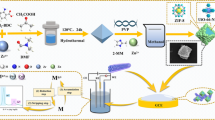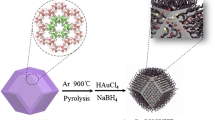Abstract
The synergistic armor-etching (SAE) approach was proposed using natural organic weak acid (tannic acid, i.e., TA) for the controllable assembly of hollow and interpenetrated HZIF-8@MWCNTs hybrid nanomaterial (ZIF-8, zeolitic imidazolate framework-8; MWCNTs, multi-walled carbon nanotubes), which exhibited highly ordered crystal structure and unique morphological characteristics. The SAE strategy not only can rapidly etch solid ZIF- material into a hollow structure (~ 10 min), but also form the TA shell (~ 33 nm) on its surface. Then, the HZIF-8@MWCNTs electrochemical sensor was constructed for selective and sensitive detection of the target molecule (dopamine, DA). A sequence of studies indicated that the fabricated TA coating was capable of promoting the spread of DA into the reactive centers of hollow MOF and MWCNTs, which exhibited outstanding electroanalytical characteristics through the synergistic effect. The DPV oxidation peak of DA was strongest at 50 mV vs. Ag/AgCl reference electrode. Under the optimal conditions, there are two linear dynamic ranges of current response of 0.01 ~ 10 and 10 ~ 550 µmol L− 1 with a detection limit of 0.003 µmol·L− 1 (S/N = 3). Simultaneously, the HZIF-8@MWCNTs electrochemical sensor could detect low levels of DA in real products. The recoveries of the actual sample tests were between 98.2% and 102%, and the relative standard deviation (R.S.D.) of all studies was less than 3.0%. The statistical analyses (F-test and t-test) were employed to demonstrate the accuracy of method developed. This work will enlighten researchers operating in the domain of MOFs composites, accelerating the advancement of electrochemical sensing on the basis of hollow MOFs materials.
Graphical Abstract








Similar content being viewed by others
References
Zhu RM, Ding JW, Jin L, Pang H (2019) Interpenetrated structures appeared in supramolecular cages, MOFs, COFs. Coord Chem Rev 389:119–140. https://doi.org/10.1016/j.ccr.2019.03.002
Sun W, Chu HC, Liu JY, Wang N, Wang Y (2023) A core-shell heterostructured hybrid nanomaterial of bi-metallic MOFs and COFs: improved 2,4,6-trichlorophenol charge collection. Sens Actuat B-chem 393:134146. https://doi.org/10.1016/j.snb.2023.134146
Zheng SS, Zhou HJ, Xue HG, Braunstein P, Pang H (2022) Pillared-layer Ni-MOF nanosheets anchored on Ti3C2 MXene for enhanced electrochemical energy storage. J Colloid Interface Sci 614:130–137. https://doi.org/10.1016/j.jcis.2022.01.094
Wang J, Li N, Xu YX, Pang H (2020) Two-dimensional MOF and COF nanosheets: synthesis and applications in electrochemistry. Chem Eur J 26:6402–6422. https://doi.org/10.1002/chem.202000294
Sun W, Zhao XH, Webb E, Xu G, Zhang WJ, Wang Y (2023) Advances in metal-organic framework-based hydrogel materials: preparation, properties and applications. J Mater Chem A 11:2092–2127. https://doi.org/10.1039/d2ta08841j
Shi YX, Zhu GY, Guo XT, Jing QL, Pang H, Zhang YZ (2023) Three-dimensional mxene-encapsulated porous Ni-NDC nanosheets as anodes for the enhanced lithium-ion batteries. Nano Res 16:2528–2535. https://doi.org/10.1007/s12274-022-5168-7
Tang YJ, Zheng SS, Xue HG, Pang H (2019) Regulation of the Ni2+ content in a hierarchical urchin-like MOF for high-performance electrocatalytic oxygen evolution. Front Chem 7:411. https://doi.org/10.3389/fchem.2019.00411
Zheng SS, Li Q, Xue HG, Pang H, Xu Q (2020) A highly alkaline-stable metal oxide@metal-organic framework composite for high-performance electrochemical energy storage. Natl Sci Rev 7:305–314. https://doi.org/10.1093/nsr/nwz137
Liu CL, Feng WH, Bai Y, Pang H (2022) Compositing MXenes with hierarchical ZIF-67/cobalt hydroxide via controllable in situ etching for a high-performance supercapacitor. Inorg Chem Front 9:5463. https://doi.org/10.1039/d2qi01641a
Liu CL, Bai Y, Li WT, Yang FY, Zhang GX, Pang H (2022) In situ growth of three-dimensional MXene/metal-organic framework composites for high-performance supercapacitors. Angew Chem Int Ed 61:e202116282. https://doi.org/10.1002/anie.202116282
Zha XQ, Zhao XH, Webb E, Khan SU, Wang Y (2023) Beyond pristine metal-organic frameworks: preparation of hollow MOFs and their composites for catalysis, sensing, and adsorption removal applications. Molecules 28:144. https://doi.org/10.3390/molecules28010144
Qiu TJ, Gao S, Liang ZB, Wang DG, Tabassum H, Zhong RQ, Zou RQ (2021) Pristine hollow metal-organic frameworks: design, synthesis and application. Angew Chem Int Ed 60:17314–17336. https://doi.org/10.1002/anie.202012699
Li N, Li Y, Li Q, Zhao Y, Liu CS, Pang H (2021) NiO nanoparticles decorated hexagonal nickel-based metal-organic framework: self-template synthesis and its application in electrochemical energy storage. J Colloid Interface Sci 518:709–718. https://doi.org/10.1016/j.jcis.2020.07.134
Cao S, Zheng SS, Pang H (2020) Ultrathin nanosheet-assembled accordion-like Ni-MOF for hydrazine hydrate amperometric sensing. Microchim Acta 187:168. https://doi.org/10.1007/s00604-020-4153-7
Shang ZJ, Su T, Jin DQ, Xu Q, Hu XY, Shu Y (2023) An integrated and flexible PDMS/Au film-based electrochemical immunosensor via Fe-Co MOF as a signal amplifier for alpha fetoprotein detection. Biosens Bioelectron 230:115245. https://doi.org/10.1016/j.bios.2023.115245
Chu HC, Sun X, Zha XQ, Zhang Y, Wang Y (2022) Synthesis of core-shell structured metal oxide@covalent organic framework composites as a novel electrochemical platform for dopamine sensing. Colloid Surf A 648:129238. https://doi.org/10.1016/j.colsurfa.2022.129238
Paapa MK, Nathalie S (2023) The potential of hyperbaric oxygen as a therapy for neurodegenerative Diseases. GeroScience 45:747–756. https://doi.org/10.1007/s11357-022-00707-z
Yan TT, Zhang XY, Zhao Y, Sun WY (2023) Stable zr(IV) coordination polymers with electroactive metal-terpyridine units for enhanced electrochemical sensing dopamine. J Mater Chem A 11:268. https://doi.org/10.1039/d2ta06797h
Xi X, Tang W, Wu DQ, Shen CC, Ji W, Li J, Su YZ, Guo XJ, Liu RL, Yan F (2023) All-carbon solution-gated transistor with low operating voltages for highly selective and stable dopamine sensing. ACS Sens 8:1211–1219. https://doi.org/10.1021/acssensors.2c02608
Cho YW, Park JH, Lee KH, Lee T, Luo ZT, Kim TH (2020) Recent advances in nanomaterial-modified electrical platforms for the detection of dopamine in living cells. Nano Converg 7:40. https://doi.org/10.1186/s40580-020-00250-7
Santhoshkumar P, Thirumalraj B, Sriram B, Karuppasamy K, Vikraman D, Kathalingam A, Choe H, Kim HS (2022) Mesoporous SnSe2-grafted N-doped carbon composites with integrated flaky structure for electrochemical sensing of carbendazim. Ceram Int 48:16023–16032. https://doi.org/10.1016/j.ceramint.2022.02.146
Wei X, Yu MM, Li C, Gong XH, Qin F, Wang ZH (2018) Magnetic nanoparticles coated with a molecularly imprinted polymer doped with manganese-doped ZnS quantum dots for the determination of 2,4,6-trichlorophenol. Microchim Acta 185:1–6. https://doi.org/10.1007/s00604-018-2742-5
Liu Y, Chen PP, Zheng S, Xing YC, Huang CB (2019) Novel fluorescent sensor using molecularly imprinted silica microsphere-coated CdSe@CdS quantum dots and its application in the detection of 2,4,6-trichlorophenol from environmental water samples. Luminescence 34:680–688. https://doi.org/10.1002/bio.3653
Arif N, Gul S, Sohail M, Rizwan S, Iqbal M (2021) Synthesis and characterization of layered Nb2C MXene/ZnS nanocomposites for highly selective electrochemical sensing of dopamine. Ceram Int 47:2388–2396. https://doi.org/10.1016/j.ceramint.2020.09.081
Yang L, Fan SM, Deng GG, Li YC, Ran X, Zhao H, Li CP (2015) Bridged β-cyclodextrin-functionalized MWCNT with higher supramolecular recognition capability: the simultaneous electrochemical determination of three phenols. Biosens Bioelectron 68:617–625. https://doi.org/10.1016/j.bios.2015.01.059
Chen YL, Huang W, Chen KJ, Zhang T, Wang Y, Wang JM (2019) A novel electrochemical sensor based on core-shell-structured metal-organic frameworks: the outstanding analytical performance towards chlorogenic acid. Talanta 196:85–91. https://doi.org/10.1016/j.talanta.2018.12.033
Jiang JJ, Ding D, Wang J, Lin X, Diao GW (2021) Three-dimensional nitrogen-doped graphene-based metal-free electrochemical sensors for simultaneous determination of ascorbic acid, dopamine, uric acid, and acetaminophen. Analyst 146:964–970. https://doi.org/10.1039/d0an01912g
Chen YL, Sun X, Biswas S, Xie Y, Wang Y, Hu XY (2019) Integrating polythiophene derivates to PCN-222(fe) for electrocatalytic sensing of L-dopa. Biosens Bioelectron 141:111470. https://doi.org/10.1016/j.bios.2019.111470
Liu CS, Li JJ, Pang H (2020) Metal-organic framework-based materials as an emerging platform for advanced electrochemical sensing. Coord Chem Rev 410:213222. https://doi.org/10.1016/j.ccr.2020.213222
Li J, Shen HF, Yu SH, Zhang GS, Ren CL, Hu XY, Yang ZJ (2020) Synthesis of a manganese dioxide nanorod-anchored graphene oxide composite for highly sensitive electrochemical sensing of dopamine. Analyst 145:3283–3288. https://doi.org/10.1039/d0an00348d
Zhang DL, Zhang JH, Pan MD, Wang Y, Sun T (2021) Necklace-like C-ZIF-8@MWCNTs fabricated by electrochemical deposition towards enhanced supercapacitor. J Alloys Compd 853:157368. https://doi.org/10.1016/j.jallcom.2020.157368
Zhang YH, Tong YP, Li XY, Guo SJ, Zhang HL, Chen X, Cai K, Cheng LH, He WW (2021) Pebax mixed-matrix membrane with highly dispersed ZIF-8@CNTs to enhance CO2/N2 separation. ACS Omega 6:18566–18575. https://doi.org/10.1021/acsomega.1c00493
Kumari G, Jayaramulu K, Maji TK, Narayana C (2013) Temperature Induced Structural transformations and Gas Adsorption in the Zeolitic Imidazolate Framework ZIF-8: a Raman Study. J Phys Chem A 117:11006–11012. https://doi.org/10.1021/jp407792a
Yakemseva M, Dierking I, Kapernaum N, Usoltseva N, Giesselmann F (2014) Dispersions of multi-wall carbon nanotubes in ferroelectric liquid crystals. Eur Phys J E 37:7. https://doi.org/10.1140/epje/i2014-14007-4
Li J, Wu Z, Duan QY, Li XD, Tan XL, Alsaedi A, Hayat T, Chen CL (2019) Mutual effects behind the simultaneous U(VI) and humic acid adsorption by hierarchical MWCNT/ZIF-8 composites. J Mol Liq 288:110971. https://doi.org/10.1016/j.molliq.2019.110971
Li HY, Li C, Wang YY, Sun MH, Dong WD, Li Y, Su BL (2022) Selenium confined in ZIF-8 derived porous carbon@MWCNTs 3D networks: tailoring reaction kinetics for high performance lithium-selenium batteries. Chem Synth 2:8. https://doi.org/10.20517/cs.2022.04
Wang ZJ, Han R, Li L, Sun JQ, Yang JY, Pan MF, Wang S (2023) Electrochemical strategy based on the synergistic effect of ZIF-8 and MWCNTs for quantitation of tert-butylhydroquinone in oils and fried chips. Microchem J 185:108286. https://doi.org/10.1016/j.microc.2022.108286
Wang YF, Zhao W, Qi ZY, Zhang L, Peng YZ (2020) Phosphate removal by ZIF-8@MWCNT hybrids in presence of effluent organic matter: adsorbent structure, wastewater quality, and DFT analysis. Sci Total Environ 745:141054. https://doi.org/10.1016/j.scitotenv.2020.141054
Wu YH, Li BY, Wang XX, Yu SJ, Pang HW, Liu Y, Liu XY, Wang XK (2019) Magnetic metal-organic frameworks (Fe3O4@ZIF-8) composites for U(VI) and Eu(III) elimination: simultaneously achieve favorable stability and functionality. Chem Eng J 378:122105. https://doi.org/10.1016/j.cej.2019.122105
Hu XW, Luo MW, Rehman MU, Sun JH, Yaseen HASM, Irshad F, Zhao YJ, Wang SP, Ma XB (2022) Mechanistic insight into the electron-donation effect of modified ZIF-8 on Ru for CO2 hydrogenation to formic acid. J Co2 Util 60:101992. https://doi.org/10.1016/j.jcou.2022.101992
Chen YL, Huang W, Chen KJ, Zhang T, Wang Y, Wang JM (2019) Facile fabrication of electrochemical sensor based on novel core-shell PPy@ZIF-8 structures: enhanced charge collection for quercetin in human plasma samples. Sens Actuat B-Chem 290:434–442. https://doi.org/10.1016/j.snb.2019.04.006
Biswas S, Chen YL, Xie Y, Sun X, Wang Y (2020) Ultrasmall au(0) inserted hollow PCN-222 MOF for the high-sensitive detection of estradiol. Anal Chem 92:4566–4572. https://doi.org/10.1021/acs.analchem.9b05841
Biswas S, Das R, Basu M, Bandyopadhyay R, Pramanik P (2016) Synthesis of carbon nanoparticle embedded graphene for sensitive and selective determination of dopamine and ascorbic acid in biological fluids. RSC Adv 6:100723–100731. https://doi.org/10.1039/c6ra16774h
Wang Y, Wang L, Chen HH, Hu XY, Ma SQ (2016) Fabrication of highly sensitive and stable hydroxylamine electrochemical sensor based on gold nanoparticles and metal-metalloporphyrin framework modified electrode. ACS Appl Mater Interfaces 8:18173–18181. https://doi.org/10.1021/acsami.6b04819
Xiao DL, Liu SB, Liang LY, Bi YP (2016) Magnetic restricted-access microspheres for extraction of adrenaline, dopamine and noradrenaline from biological samples. Microchim Acta 183:1417–1423. https://doi.org/10.1007/s00604-016-1768-9
Hou XY, Huang W, Tong YK, Tian MM (2019) Hollow dummy template imprinted boronate-modified polymers for extraction of norepinephrine, epinephrine and dopamine prior to quantitation by HPLC. Microchim Acta 186:686. https://doi.org/10.1007/s00604-019-3801-2
Liu XQ, Fang Y, Zhu DQ, Wang JY, Wu Y, Wang T, Wang YQ (2023) Hollow structure molecularly imprinted ratiometric fluorescence sensor for the selective and sensitive detection of dopamine. Analyst 148:2844. https://doi.org/10.1039/d3an00528c
Acknowledgements
The research was financially supported through the National Natural Science Foundation of China (NO.22174124), Top-notch Academic Programs Project of Jiangsu Higher Education Institutions (TAPP), and a project funded by the Priority Academic Program Development of Jiangsu Higher Education Institutions (PAPD).
Author information
Authors and Affiliations
Contributions
Wang Sun: Investigation, Methodology, Data supervision, Writing - original draft. Junyan Liu: Validation, Software, Methodology. Huacong Chu: Validation, Software. Yang Wang: Funding acquisition, Formal analysis, Resources.
Corresponding author
Ethics declarations
Competing interest
All authors state that they have no conflict of interest.
Additional information
Publisher’s Note
Springer Nature remains neutral with regard to jurisdictional claims in published maps and institutional affiliations.
Electronic supplementary material
Below is the link to the electronic supplementary material.
Rights and permissions
Springer Nature or its licensor (e.g. a society or other partner) holds exclusive rights to this article under a publishing agreement with the author(s) or other rightsholder(s); author self-archiving of the accepted manuscript version of this article is solely governed by the terms of such publishing agreement and applicable law.
About this article
Cite this article
Sun, W., Liu, J., Chu, H. et al. Controllable assembly of hollow interpenetrated zeolite imidazole framework nanocomposite for dopamine charge collection. Microchim Acta 191, 48 (2024). https://doi.org/10.1007/s00604-023-06137-8
Received:
Accepted:
Published:
DOI: https://doi.org/10.1007/s00604-023-06137-8




